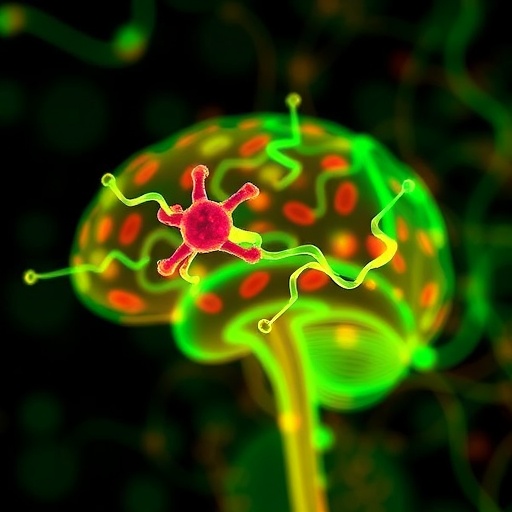In a groundbreaking study published in Schizophrenia journal, researchers have revealed promising new insights into the mechanisms underlying working memory improvements in schizophrenia, focusing on peripheral subunits of N-methyl-D-aspartate receptors (NMDARs). This discovery not only advances our understanding of cognitive deficits characteristic of schizophrenia but also suggests novel avenues for targeted intervention and personalized treatment strategies.
Working memory—the brain’s ability to temporarily hold and manipulate information—is crucial for daily functioning, problem-solving, and decision-making. Unfortunately, individuals with schizophrenia often endure profound impairments in working memory, significantly affecting their quality of life. Although previous research has extensively studied central nervous system dysfunctions, this latest investigation pivots attention to peripheral NMDAR subunits, signaling a potentially transformative approach in biomarker identification and therapeutic prediction.
NMDARs are glutamate receptor proteins essential for synaptic plasticity and memory formation. Traditionally, studies have centered on the brain’s NMDAR activity, linking receptor hypofunction to the cognitive and negative symptoms seen in schizophrenia. However, the innovative angle in this research lies in quantifying peripheral NMDAR subunits—those expressed outside the central nervous system—as surrogate indicators of central changes. This peripheral assessment offers a less invasive, more accessible method to evaluate and predict cognitive outcomes.
The researchers employed sophisticated molecular techniques to isolate and measure distinct peripheral NMDAR subunits. Their analysis demonstrated a significant correlation between the expression patterns of these subunits and subsequent improvements in working memory performance among schizophrenia patients undergoing cognitive training. Importantly, specific subunit profiles acted as reliable predictors, outperforming previously used markers in sensitivity and specificity.
This finding challenges conventional paradigms and beckons a reevaluation of schizophrenia’s neurobiological underpinnings. It implies that peripheral tissues might echo central neuropathological alterations, thereby serving as a practical window into the brain’s functional state. The prospect of peripheral biomarkers predicting individual treatment responses opens doors to precision psychiatry, where interventions can be tailored based on a patient’s unique molecular signature.
Moreover, the study delved into the dynamic nature of NMDAR subunit composition during therapeutic regimens. It was observed that fluctuations in peripheral subunit levels directly mirrored working memory gains, suggesting a bidirectional relationship. This responsiveness indicates not only predictive but also potentially prognostic utility, enabling clinicians to monitor progress and adjust treatments in real-time.
Technically, the researchers utilized advanced immunoassays coupled with quantitative PCR to detect mRNA and protein levels of NMDAR subunits in peripheral blood samples. These modalities facilitated high-throughput, reproducible measurements with minimal patient discomfort. The analytical rigor guarantees that the identified associations are robust and replicable, reinforcing the study’s credibility.
The implications extend beyond working memory alone. Given NMDAR’s centrality in synaptic modulation, peripheral subunit profiling might be extrapolated to understand other cognitive domains and psychotic symptoms. Future investigations could explore the applicability of this approach in early diagnosis, risk stratification, and even in monitoring neurodegenerative trajectories in related disorders.
This research also revives interest in the glutamatergic system’s peripheral biology, previously underexplored in psychiatric contexts. Understanding peripheral glutamate receptor dynamics might shed light on systemic factors contributing to schizophrenia’s heterogeneity. It encourages interdisciplinary collaborations marrying neurobiology, immunology, and psychiatry to unravel complex disease mechanisms.
Importantly, translating these findings into clinical practice warrants further validation in larger, diverse cohorts. It is essential to determine the specificity of peripheral NMDAR subunit profiles against confounders such as medication effects, comorbidities, and lifestyle factors that could influence receptor expression. Longitudinal studies tracking patients over extended periods will clarify the temporal stability and clinical relevance of these biomarkers.
Additionally, the discovery raises intriguing questions about peripheral-to-central communication pathways. Could peripheral signals actively modulate central NMDAR function, or are they merely passive reflections of brain state? Clarifying this causal nexus would deepen mechanistic understanding and potentially inspire novel therapeutics targeting peripheral receptor sites.
From a therapeutic perspective, these insights could inspire development of peripheral receptor modulators or biologics designed to augment NMDAR function indirectly. Such treatments might complement existing antipsychotic medications, which primarily target dopaminergic systems, thus addressing unmet needs in cognitive remediation.
This study epitomizes the shifting landscape in neuropsychiatric research, emphasizing biomarkers accessible through minimally invasive techniques. It aligns with global movements toward precision medicine, where molecular phenotyping guides clinical decision-making. Ultimately, it offers hope for enhancing cognitive outcomes and life trajectories of individuals grappling with schizophrenia.
As the research community digests these findings, the potential to revolutionize schizophrenia management by integrating peripheral NMDAR subunit profiling is becoming unmistakably clear. It underscores the vitality of innovative approaches that transcend traditional brain-centric frameworks, opening realms of possibilities for diagnosis, treatment, and understanding complex mental health disorders.
In conclusion, the identification of peripheral NMDAR subunits as predictors of working memory improvement marks an important stride in schizophrenia research. By bridging peripheral molecular signatures with central cognitive function, this study lays the groundwork for the next generation of biomarker-driven, personalized psychiatry. The ripple effects of this discovery are poised to resonate through clinical practice and scientific inquiry alike, elevating hopes for more effective, individualized interventions in schizophrenia.
Subject of Research: Working memory improvement in schizophrenia through peripheral NMDAR subunits
Article Title: Peripheral NMDAR subunits as predictors of working memory improvement in schizophrenia
Article References:
Qin, X., Hou, W., Mao, Z. et al. Peripheral NMDAR subunits as predictors of working memory improvement in schizophrenia. Schizophr 11, 133 (2025). https://doi.org/10.1038/s41537-025-00679-x
Image Credits: AI Generated
DOI: https://doi.org/10.1038/s41537-025-00679-x




